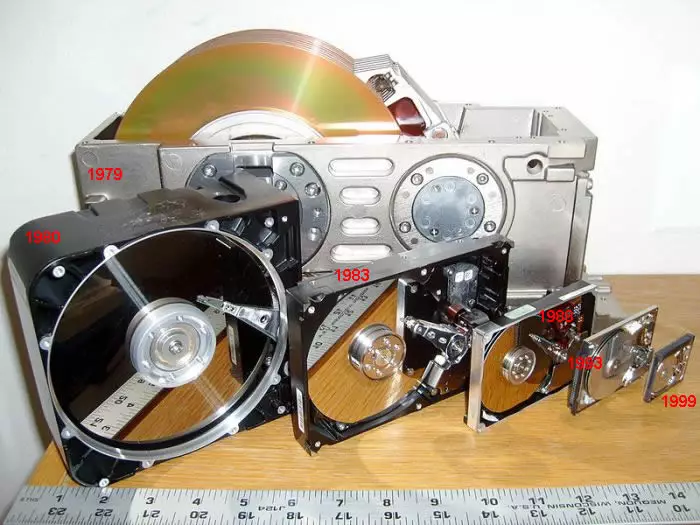Harddrives have changed a lot since 1979 thats for sure. This thing you see here on the picture is a 5MB 8 inch harddrive from Shugart, and now we can fit gigabytes onto hardrives as small as fingernails. We can even make wireless harddrives. Click more to see deatils on these fine specimens and also a look at the worlds smallest harddisk.
1979 5MB 8 inch: 9.5 in × 4.624 in × 14.25 in (241.3 mm × 117.5 mm × 362 mm) In 1979, Shugart Associates’ SA1000 was the first form factor compatible HDD, having the same dimensions and a compatible interface to the 8inch FDD.
1980 15MB 5.25 inch: 5.75 in × 3.25 in × 8 in (146.1 mm × 82.55 mm × 203 mm) This smaller form factor, first used in an HDD by Seagate in 1980, was the same size as full-height 51/4-inch-diameter (130 mm) FDD, 3.25-inches high. This is twice as high as “half height”; i.e., 1.63 in (41.4 mm). Most desktop models of drives for optical 120 mm disks (DVD, CD) use the half height 5¼inch dimension, but it fell out of fashion for HDDs. The Quantum Bigfoot HDD was the last to use it in the late 1990s, with “low-profile” (˜25 mm) and “ultra-low-profile” (˜20 mm) high versions.
1983 100MB 3.5 inch: 4 in × 1 in × 5.75 in (101.6 mm × 25.4 mm × 146 mm) = 376.77344 cm³ This smaller form factor, first used in an HDD by Rodime in 1983, was the same size as the “half height” 3½inch FDD, i.e., 1.63 inches high. Today it has been largely superseded by 1-inch high “slimline” or “low-profile” versions of this form factor which is used by most desktop HDDs.
1988 2,500MB 2.5 inch: 2.75 in × 0.275–0.59 in × 3.945 in (69.85 mm × 7–15 mm × 100 mm) = 48.895–104.775 cm3 This smaller form factor was introduced by PrairieTek in 1988; there is no corresponding FDD. It is widely used today for solid-state drives and for hard-disk drives in mobile devices (laptops, music players, etc.) and as of 2008 replacing 3.5 inch enterprise-class drives. It is also used in the Playstation 3 and Xbox 360 video game consoles. Today, the dominant height of this form factor is 9.5 mm for laptop drives (usually having two platters inside), but higher capacity drives have a height of 12.5 mm (usually having three platters). Enterprise-class drives can have a height up to 15 mm. Seagate released a 7mm drive aimed at entry level laptops and high end netbooks in December 2009.
1993 125,000MB 1.8 inch: 54 mm × 8 mm × 71 mm = 30.672 cm³ This form factor, originally introduced by Integral Peripherals in 1993, has evolved into the ATA-7 LIF with dimensions as stated. It was increasingly used in digital audio players and subnotebooks, but is rarely used today. An original variant exists for 2–5GB sized HDDs that fit directly into a PC card expansion slot. These became popular for their use in iPods and other HDD based MP3 players.
1999 750,000MB 1 inch: 42.8 mm × 5 mm × 36.4 mm This form factor was introduced in 1999 as IBM’s Microdrive to fit inside a CF Type II slot. Samsung calls the same form factor “1.3 inch” drive in its product literature.
The Guinness Book of World Records has credited Toshiba with creating the world’s smallest hard drive. These hard drives are less than one inch wide–about the size of a postage stamp–yet can store up to 4 GB. Only 7 years ago 4 GB hard drives were common in desktop computers. Toshiba unveiled these diminutive devices in January, and expects to begin producing them by the end of 2004. On the other end of the spectrum, 400 GB hard drives are now available. For much of the 1990s disk drive capacities were doubling every year. The rate of increase has slowed substantially, but hard drives are still doubling in capacity every other year, essentially mirroring Moore’s Law. This trend should continue for at least the next several years, resulting in terabyte desktop hard drives and 20 GB microdrives by the end of the decade. Only 50 years ago IBM introduced the first hard drive, called RAMAC. RAMAC was a contraption the size of several washing machines, and was capable of storing 5 MB. Toshiba’s microdrive is less than 1/1000 the size of RAMAC, yet can store almost 1,000 times as much information. Thanks to h00kw0rm for the heads-up.











the size of several washing machines